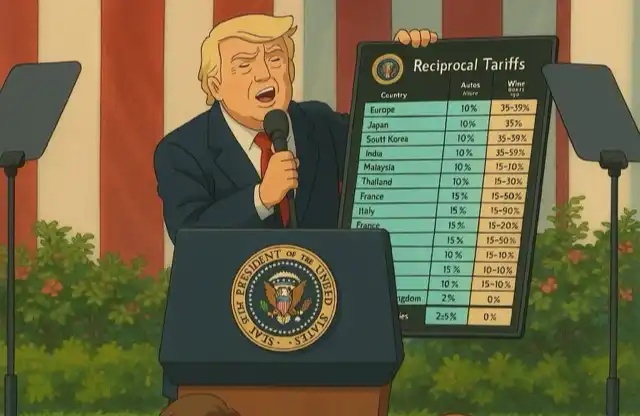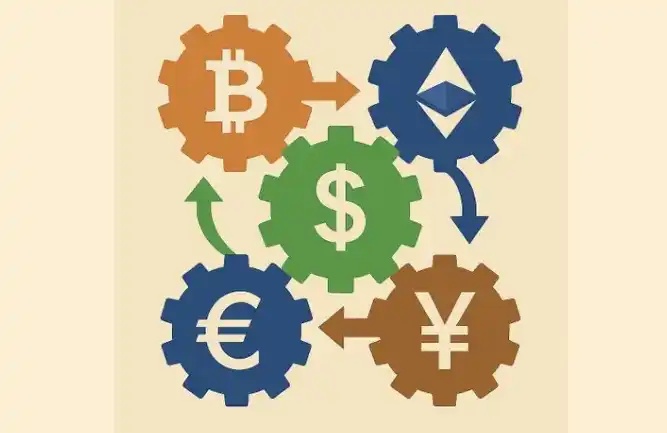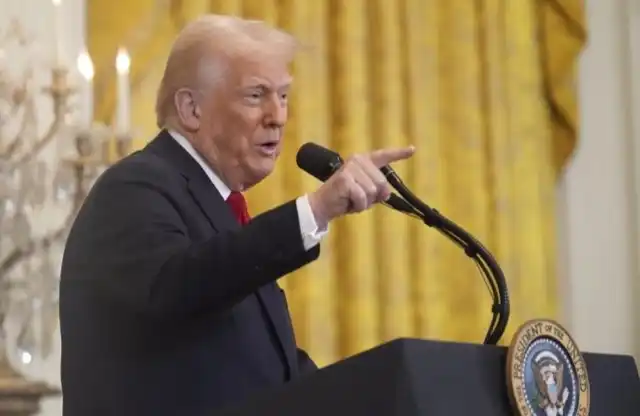The US Stock Market Witnessed a $2 Trillion Meltdown in 15 Minutes, Is "Tit-for-Tat Tariffs" the Straw That Broke the Bull Market's Back?
The shoe has finally dropped as U.S. President Trump signed two executive orders at the White House last night regarding so-called "reciprocal tariffs," announcing that the U.S. will establish a 10% "minimum benchmark tariff" on trade partners and impose higher tariffs on certain trade partners.
Trump displayed a large sign labeled "Reciprocal Tariffs," outlining which trade partners the U.S. plans to tax and at what tariff rate. Among them, the UK 10%, Brazil 10%, Australia 10%, the Philippines and Israel 17%, the EU 20%, Japan 24%, South Korea 25%, India 26%, South Africa 30%, Switzerland 31%, Indonesia 32%, Sri Lanka 44%, Vietnam 46%, Cambodia 49%, and so on.

A senior White House official stated that the benchmark tariff rate (10%) will take effect early on April 5, and reciprocal tariffs will take effect early on April 9.
U.S. Treasury Secretary Besent tweeted, "I suggest that all countries refrain from taking retaliatory actions. We can see if there will be a different tariff floor (from the published figures). Trump's mindset may be to temporarily stabilize things. I was not involved in the negotiations; we will see if there are any negotiations before April 9 (the date when reciprocal tariffs take effect)."
Rally and Plunge: Both Cryptocurrencies and Stocks Under Indiscriminate Attack
Just hours before Trump announced the tariff policy, the U.S. stock market experienced severe volatility. Nasdaq index futures widened losses to 2.4%, while S&P 500 index futures fell 1.6%. Reuters reported that this indicated investors expected a sharp decline in the market opening on the 3rd. After the tariff policy was implemented, the U.S. Dollar Index (DXY) resumed its decline, dropping below the low point when Trump announced comprehensive tariffs, currently trading at 103.24, compared to above 104 when reciprocal tariffs were announced.

In the crypto market, when Trump initially announced that the benchmark tariffs would all be 10% at the start of the early morning meeting, Bitcoin surged to $88,000, reaching a new high since March 25, up over 5%; however, after announcing additional tariffs on about 60 countries with the largest trade imbalances with the U.S., Bitcoin gave up most of its gains, falling below $82,500. Judging by Bitcoin's current performance, it can be said that it has no safe-haven properties. Meanwhile, spot gold briefly broke through $3,160 per ounce, continuing to hit a historical high.

The altcoin market has been in a pitiful state after this round of rally and plunge. According to Coinglass data, the entire network liquidated $293 million in the past 4 hours, with long liquidations accounting for $187 million and short liquidations for $106 million.

Absurd Tariff Calculation Method
Trump claimed that the new tariff measures are aimed at promoting American manufacturing, "making America prosperous again," and bringing back "jobs and factories," even declaring that the April 2nd imposition of "reciprocal tariffs" would be America's "liberation day." However, at the same time, the Southeast Asian region has been hit hard by tariff increases, with Vietnam facing a 46% increase, Thailand a 36% increase, Cambodia a 49% increase, causing significant damage to the industrial sector.
According to crypto KOL Fiona, after Trump's election, many entrepreneurs believed that the U.S. would impose the highest taxes on China, so many went to Southeast Asia, especially Thailand and Vietnam, to buy land and build factories. Due to the size of this group, in a very short time, the price of industrial land in these areas skyrocketed. Similar to a housing rush, they rushed to buy land, coupled with a series of costs related to local labor law registration, costing a significant amount of money.
For example, Nike employs over 450,000 workers in its 130 factories in Vietnam. Currently, its stock price has dropped over 6%, and due to the tariffs, Nike's brand revitalization plan will also be affected. Nike's production capacity in Vietnam accounts for over 50% of its global total production. This potential tariff policy is expected to cost Nike over $400 million in additional costs annually.

For the United States, implementing absolute reciprocal tariffs will not benefit American businesses and the public. For example, although it may increase U.S. federal revenue in the short term, in the long run, it will cause U.S. commodity prices to soar, leading to higher inflation.
Economists are concerned that Trump's tariff policy will inevitably raise U.S. inflation and damage consumer confidence. Projections from the Yale Budget Lab show that after the implementation of "reciprocal tariffs," if other countries do not take retaliatory measures, U.S. personal consumption expenditure prices will rise by 1.7% in the short term, and the real GDP growth rate in 2025 will decrease by 0.6 percentage points. If other countries take retaliatory measures, the rise in U.S. personal consumption expenditure prices will expand to 2.1%, and the real GDP growth rate will decrease by 1 percentage point.
Ironically, the so-called "tariff rate" data released by the Trump administration is itself the result of an absurd calculation method. He claims that some countries impose tariffs of up to 30%, 40%, or even over 50% on American products, but the fact is that these numbers do not stem from actual tariffs or non-tariff barriers but from a pseudo-scientific formula of "using the trade deficit divided by the partner's total exports."

For example, the United States has a $17.9 billion trade deficit with Indonesia, while Indonesia's exports to the U.S. amount to $28 billion. Dividing $17.9 by $28 gives 64%, which prompted Trump to claim this as Indonesia's tariff rate on the U.S. Similarly, the EU, Israel, South Korea, and other countries have had dozens of percentage points of "false tariff rates" concocted in a similar manner, even disregarding existing trade agreements with South Korea.
This misunderstanding of "comparative advantage" and the international trade structure has turned the so-called "equal tariffs" into a political slogan and a tool for showmanship. Ironically, while Trump accuses other countries of unfair high taxes, he himself imposes extreme tariffs, inadvertently harming U.S.-based companies, brands, and middle-class consumers that have long since relocated overseas.
Moreover, the high tariffs have not effectively led to a resurgence in manufacturing. From Trump's first term to Biden taking over, the U.S. government has consistently promoted reshoring, but over the past 8 years, the reshoring effect has been limited. Instead, due to fluctuating trade policies and increased cost uncertainties, overseas capital has become more cautious about investing in the United States.
It can be said that this behavior of using the trade deficit to "fabricate tariff rates" not only demonstrates a disregard for the basic principles of the international economy but also reveals the short-sightedness and infighting within the entire policy design. Trump's tariff policy, rather than being about "making America great again," is more like a game of miscalculating accounts, pushing reality into a period of inflation and investment chill, ultimately harming others and not benefiting oneself.
Bottom Fishing or Cash Position: How Will the Cryptocurrency Market Perform Next?
The tariff results from last night can be described as the worst-case scenario that the market had previously speculated, with various impacts on the global financial market.
Former Ark Invest crypto lead and current Placeholder VC partner Chris Burniske stated in a post that he originally expected today (April 2) to be a positive turning point, believing the market was overly defensive, but reality proved otherwise. He mentioned that he still hopes that tariff negotiations will proceed quickly, saying, "I will not take drastic action; if the market remains in this range, I will choose to continue holding. If there is a gap-down due to today's trend, I will look at some targets and consider adding to my position opportunistically."

BitMEX co-founder Arthur Hayes stated, "The market doesn't seem to like 'Liberation Day' very much. If Bitcoin can hold above $76,500 between now and U.S. tax day (April 15th), then we are out of the woods."

Welcome to join the official BlockBeats community:
Telegram Subscription Group: https://t.me/theblockbeats
Telegram Discussion Group: https://t.me/BlockBeats_App
Official Twitter Account: https://twitter.com/BlockBeatsAsia
 Forum
Forum OPRR
OPRR Finance
Finance
 Specials
Specials
 On-chain Eco
On-chain Eco
 Entry
Entry
 Podcasts
Podcasts
 Data
Data


 Summarized by AI
Summarized by AI







